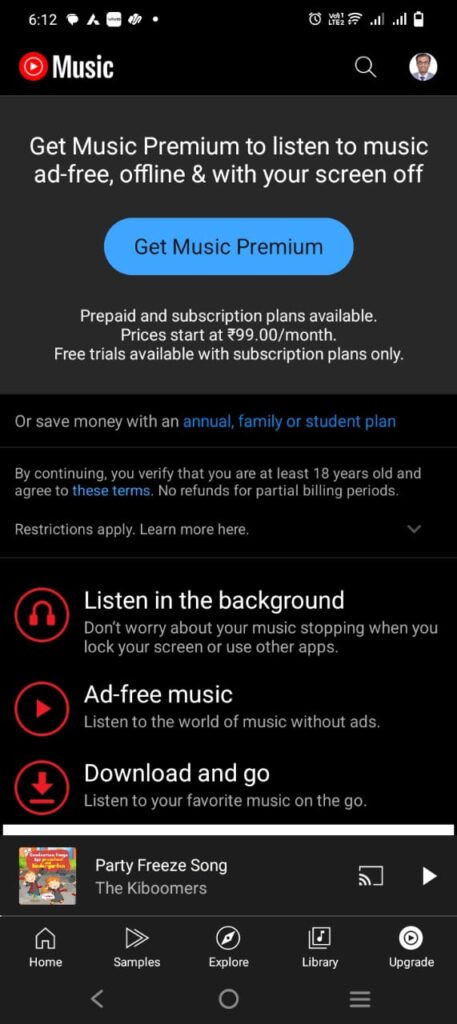I’ve been on the hunt for some cool music apps lately. I’m hoping to find something that will help my kiddo cut down on the screen time. My objective is to swap out some of that screen time for a bit of listening and dancing time.
I have narrowed down my choice of music apps to two – YT Music and Spotify. I chose YT Music because it was pre-installed on my Android phone, and Spotify because it is a popular choice. However, from day one, both apps have been trying to convince me to upgrade to their premium plans. It is fascinating to see how these apps use different strategies to persuade users to upgrade.
In this case study, I will share my insights on how these apps use nudge tactics to encourage users to upgrade to a premium plan.
To begin with, I want to make it clear that I usually don’t opt for premium services unless it’s absolutely necessary. Something interesting caught my attention lately. I realized that managing music streaming services is not the same as managing video streaming services. Let me explain.
YouTube has a massive user base of 2.7 billion active users, but only around 100 million of them are paid subscribers. This means that less than 5% of YouTube users are paid subscribers. On the other hand, Spotify has 574 million users worldwide, and a significant portion of its user base, 226 million, are paid subscribers. That means more than 40% of Spotify users are paid subscribers.
It is fascinating to note that there is such a significant difference in the conversion rate between these two amazing platforms. This difference could be attributed to many factors, I can think of the below as the primary drivers.
1. Nature of the streaming media and linked persona expectation
2. Frequency of interruptions
What does that mean?
Music is primarily enjoyed through listening and requires minimal visual engagement, unlike video streaming. Hence, there should be less manual intervention.
Also, It is worth noting that the average length of a music track is typically 3.5 minutes, which is much shorter than the average length of a video stream (8-12 minutes). As a result, audio platforms tend to have a higher frequency of ads compared to video platforms in order to monetize. This can be frustrating for active users and may explain why there is a significant difference in the conversion ratios between the two types of platforms.
I tried to compare the nudge strategies of two apps objectively. However, I needed a more acceptable yardstick for this comparison. During my research, I discovered a model called Fogg’s Behavioral Model, which was developed by a well-known behavioral scientist – Fogg
As per this model, for any behavior to take place, three elements are required – Trigger, Motivation & Ability.
Behavior = [Motivation]. [Ability]. [Trigger]
What is Motivation?
Fogg states that all human beings are motivated to:
– Seek Pleasure
– Avoid Pain
– Seek Hope
– Avoid Fear
– Seek social acceptance
– Avoid Rejection
Not all these motivators are applicable in our case. But, let’s see how these apps fare in this dimension of seeking Pleasure and Avoiding pain.
| Motivator/ Dimension | YT Music | Spotify |
| Seek Pleasure | Listen in the background; Download & Listen to songs offline; Switch between Audio & Video; Custom shuffle [Free]; | Listen in the background [Free]; Download to listen offline; 2x higher sound quality ; Custom shuffle; |
| Avoid Pain | Ad-free music ; | Ad-free music ; |


One strong motivator Spotify uses is providing 30 minutes of ad-free music after the user watches a full ad, allowing them to experience the pleasure of ad-free listening implicitly.
Let’s explore the second dimension of the model.
What is Ability?
Simply put, how simple it is to take an action once you are motivated.
Let’s take a look at the “Premium” web page is designed in both these apps to look at how simple the Click-through actions are.
| Motivator/ Dimension | YT Music | Spotify |
| Ability to take action | Primary Plan – Prominent button; Other Plans [Annual, Family, Student] – Not so prominent Links; | Primary Plan – Prominent button; Other Plans [Annual, Family, Student] – Prominent buttons; |


Let’s explore the third dimension of the model.
What is Trigger?
Triggers are the cues to the user to take the intended action.
In-App triggers and external triggers are some examples.
| Motivator/ Dimension | YT Music | Spotify |
| Trigger | No upfront labelling; Visible only after clicking; Bundling with Youtube [Powerful trigger]; Push Notifications; | Upfront labelling; More impressions even before clicking; Festive Offers; No Bundling; Unskippable Ads; Push Notifications; |




